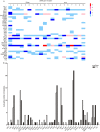Genetic alterations in cfDNA of benign and malignant thyroid nodules based on amplicon-based next-generation sequencing
- PMID: 33178757
- PMCID: PMC7607131
- DOI: 10.21037/atm-20-4544
Genetic alterations in cfDNA of benign and malignant thyroid nodules based on amplicon-based next-generation sequencing
Abstract
Background: Circulating cell-free DNA (cfDNA) serves as a biomarker in multiple malignant diseases. However, controversy still surrounds the role of cfDNA detection in the diagnosis and monitoring of papillary thyroid carcinoma (PTC). This study set out to identify the role of cfDNA detection in distinguishing between benign and malignant thyroid nodules.
Methods: Tissue, blood cell, and plasma samples were collected from 10 patients with benign nodules and 10 patients with malignant nodules. The DNA isolated from these samples was subject to PCR-based amplification using primers designed for 50 proto-oncogenes and tumor suppressor genes. PCR products were sequenced using Illumina technology, and the mutations were detected with varScan among sequencing data for each sample and comparative analysis was carried out.
Results: Through amplicon sequencing, we found one non-synonymous somatic mutation in the benign nodules and three in the malignant nodules. Among these four mutations, BRAFV600E mutation was detected in the tissue samples of 8 out of the 10 PTC patients, but it was not detected in the benign nodules. However, no BRAFV600E mutation was detected in cfDNA. Further differential analysis of cfDNA indicated that some genes had more mutations in benign patients than in malignant patients, such as MET and IDH, and some genes had more mutations in malignant patients, such as PIK3CA and EZH2.
Conclusions: We found that BRAFV600E mutation was a credible disease-related mutation in PTC; however, it could not be detected in cfDNA. Moreover, there was a large difference in mutation gene distribution between benign and malignant thyroid nodules.
Keywords: BRAF; Cell-free DNA (cfDNA); papillary thyroid carcinoma; thyroid nodule.
2020 Annals of Translational Medicine. All rights reserved.
Conflict of interest statement
Conflicts of Interest: All authors have completed the ICMJE uniform disclosure form (available at http://dx.doi.org/10.21037/atm-20-4544). The authors have no conflicts of interest to declare.
Figures



Similar articles
-
Hypermethylated RASSF1 and SLC5A8 promoters alongside BRAFV600E mutation as biomarkers for papillary thyroid carcinoma.J Cell Physiol. 2020 Oct;235(10):6954-6968. doi: 10.1002/jcp.29591. Epub 2020 Feb 4. J Cell Physiol. 2020. PMID: 32017063
-
Clinical implication of highly sensitive detection of the BRAF V600E mutation in fine-needle aspirations of thyroid nodules: a comparative analysis of three molecular assays in 4585 consecutive cases in a BRAF V600E mutation-prevalent area.J Clin Endocrinol Metab. 2012 Jul;97(7):2299-306. doi: 10.1210/jc.2011-3135. Epub 2012 Apr 12. J Clin Endocrinol Metab. 2012. PMID: 22500044
-
Detection of Circulating Tumor DNA in Patients with Thyroid Nodules.Int J Endocrinol. 2021 Aug 23;2021:8909224. doi: 10.1155/2021/8909224. eCollection 2021. Int J Endocrinol. 2021. PMID: 34475951 Free PMC article.
-
Circulating BRAFV600E in the diagnosis and follow-up of differentiated papillary thyroid carcinoma.J Clin Endocrinol Metab. 2013 Aug;98(8):3359-65. doi: 10.1210/jc.2013-1072. Epub 2013 Jun 20. J Clin Endocrinol Metab. 2013. PMID: 23788690
-
Cell-Free DNA Analysis within the Challenges of Thyroid Cancer Management.Cancers (Basel). 2022 Oct 31;14(21):5370. doi: 10.3390/cancers14215370. Cancers (Basel). 2022. PMID: 36358788 Free PMC article. Review.
Cited by
-
Detection of the BRAFV600E Mutation in Circulating Free Nucleic Acids as a Biomarker of Thyroid Cancer: A Review.J Clin Med. 2024 Sep 12;13(18):5396. doi: 10.3390/jcm13185396. J Clin Med. 2024. PMID: 39336882 Free PMC article. Review.
-
Translational Utility of Liquid Biopsies in Thyroid Cancer Management.Cancers (Basel). 2021 Jul 9;13(14):3443. doi: 10.3390/cancers13143443. Cancers (Basel). 2021. PMID: 34298656 Free PMC article. Review.
-
Towards precision medicine in thyroid cancer.Ann Transl Med. 2020 Oct;8(19):1212. doi: 10.21037/atm-20-6450. Ann Transl Med. 2020. PMID: 33178744 Free PMC article. No abstract available.
-
ccfDNA analysis for the classification of adrenocortical adenomas.J Endocrinol Invest. 2025 May;48(5):1207-1216. doi: 10.1007/s40618-025-02540-5. Epub 2025 Feb 1. J Endocrinol Invest. 2025. PMID: 39891827 Free PMC article.
-
Evaluating Liquid Biopsy for Circulating Tumor DNA (ctDNA) Detection as a Complementary Diagnostic Tool in Thyroid Cancer Among Ecuadorian Women.Int J Mol Sci. 2025 Jul 21;26(14):6987. doi: 10.3390/ijms26146987. Int J Mol Sci. 2025. PMID: 40725233 Free PMC article.
References
-
- Haugen BR, Alexander EK, Bible KC, et al. 2015 American Thyroid Association Management Guidelines for Adult Patients with Thyroid Nodules and Differentiated Thyroid Cancer: The American Thyroid Association Guidelines Task Force on Thyroid Nodules and Differentiated Thyroid Cancer. Thyroid 2016;26:1-133. 10.1089/thy.2015.0020 - DOI - PMC - PubMed
LinkOut - more resources
Full Text Sources
Research Materials
Miscellaneous
